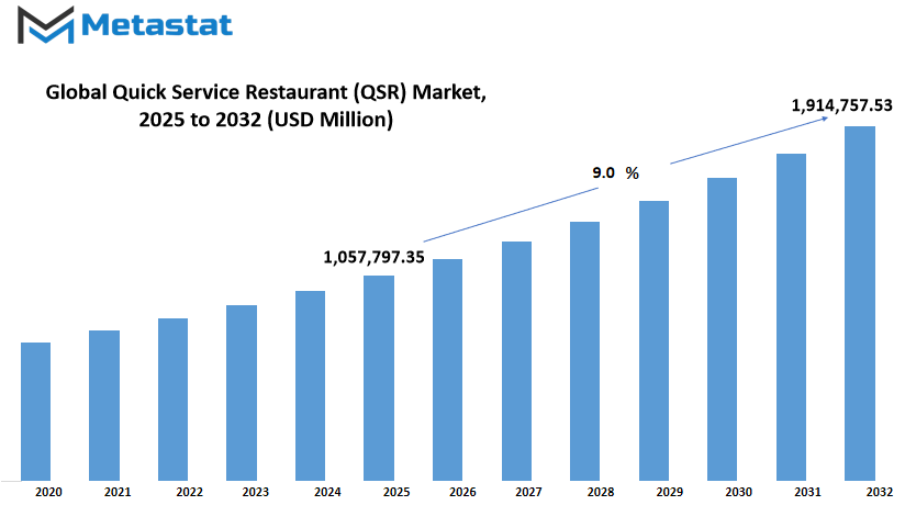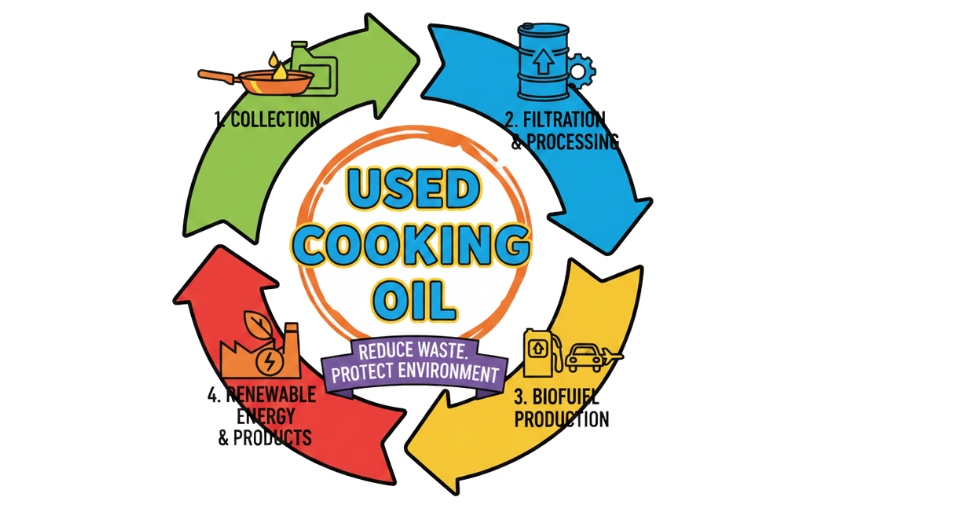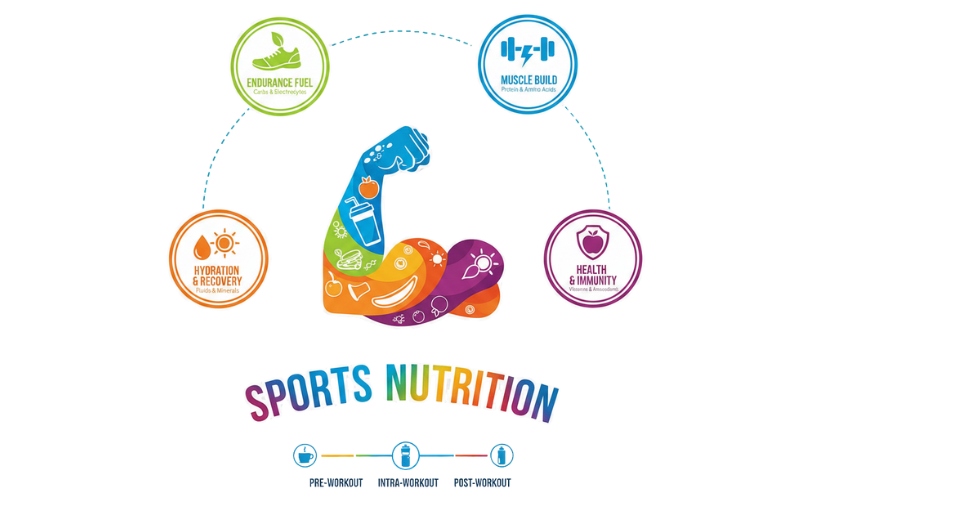MARKET OVERVIEW
The global quick service restaurant (QSR) market remain in focus as eating habits change and cultures engage with each other differently. Fundamentally, this market embodies the consistent demand for affordable food experiences offering the convenience of quality on a familiar standard. In contrast to the historical dinner formats, the QSR segment has always been defined by its capacity to deliver high numbers of customers over short time periods, but what will distinguish it in the years to come is not merely speed but responsiveness to changing lifestyles on continents. Among the distinguishing features of the worldwide quick service restaurant (QSR) market will be its penetration across classes, geographies, and generations.
In big city metropolises, QSR brands will remain cultural convergence points, not dining spots. In smaller towns, they will be hubs of contemporary retail centers where families and young professionals are drawn to affordability and consistency. This dualism—providing familiarity while conforming to local standards—will impart the market an elasticity that few sectors can boast. The sector will also be characterized by how it intersects with technological change. Order processes, delivery methods, and payment systems will all continue to improve, smoother for consumers.
But above all that, the global quick service restaurant (QSR) market will be defined by how brands respond to cultural identities via menus. A burger restaurant in one nation will not be the same as a burger restaurant in another, but the guarantee of speedy service will tie them together. This cultural adaptability will make the industry accessible to a wide range of customers while permitting it to showcase local tastes within an international context. It is also evident that the global quick service restaurant (QSR) market will remain a barometer of social change. While work schedules become more compressed and city migration becomes more prevalent, patrons will increasingly look for convenient food solutions. The QSR sector will be both a solution and an expression of that fact.
Concurrently, developing markets will see an enhanced role in this environment with QSR centers becoming a part of urban culture in areas where eating out will take on more significance than ever. The nature of this marketplace is not only what one consumes but how one engages with food. Eating at a quick service restaurant is not merely about satisfaction of hunger; it is a ritual of contemporary life in which affordability, predictability, and speed converge. The international quick service restaurant (QSR) industry will thus be one of the few sectors that cross cultures without losing individuality. The next few years will not merely broaden its geographical reach but intensify its impact on the way societies think about dining, entertainment, and even social bonding.
Lastly, the future of the international quick service restaurant (QSR) industry will not be driven by any single aspect but by its ongoing capacity to keep merging uniform service with local identity. It will continue to be a strong reflection of how convenience and culture can sit at the same table.
Global quick service restaurant (QSR) market is estimated to reach $1,914,757.53 Million by 2032; growing at a CAGR of 9.0% from 2025 to 2032.

GROWTH FACTORS
The global quick service restaurant (QSR) market is expected to see steady growth as consumer habits continue to change, and technology reshapes how food is accessed. The need for convenience and speed will remain one of the strongest factors driving this growth. With busy lifestyles becoming more common, more consumers are turning to drive-thru, delivery, and takeout options as everyday choices rather than occasional indulgences. This shift will keep pushing QSR chains to improve accessibility and efficiency in order to meet rising expectations.
Digital integration will also shape the future of the global market. Ordering apps, self-service kiosks, and personalized loyalty programs are creating new ways to connect with customers while speeding up the ordering process. The convenience of placing an order with a few taps on a phone and the ability to customize preferences will strengthen customer loyalty. In addition, digital data insights will allow operators to understand consumer behavior better and adjust menus or promotions in real time. This will provide a strong foundation for ongoing growth.
Despite these opportunities, the global quick service restaurant (QSR) market faces challenges that cannot be ignored. Intense competition across both global and local brands will continue to put pressure on profit margins. With so many players fighting for market share, maintaining customer loyalty will be increasingly difficult. Rising costs related to supply chains and commodity price inflation add another layer of uncertainty. These factors could limit profit growth even in periods of strong sales. Addressing these challenges will require careful planning and innovation in cost management.
At the same time, opportunities in emerging markets present an optimistic outlook for the global market. As middle-class populations expand in regions such as Asia, Africa, and Latin America, the demand for affordable, convenient dining will rise. International players entering these regions will be able to benefit from an untapped consumer base eager for new options. This expansion will not only increase sales but also diversify revenue streams beyond saturated markets.
Looking ahead, the global quick service restaurant (QSR) market will be shaped by the balance between growth opportunities and operational challenges. Those who adopt advanced digital tools, prioritize convenience, and expand thoughtfully into new regions will be positioned for success. While competition and cost pressures will remain significant, the long-term outlook suggests that innovation and adaptability will keep this market moving forward with resilience and growth potential.
MARKET SEGMENTATION
By Structure
The global quick service restaurant (QSR) market is growing steadily and will continue to play a key role in shaping the future of the food service industry. This market is influenced by rising urbanization, changing eating habits, and the demand for fast, affordable, and accessible food options. Increasing digital adoption and the use of innovative technologies in ordering, delivery, and customer engagement will push this market toward even greater expansion. The focus will not only remain on speed and affordability but also on sustainability, healthier menus, and enhanced customer experiences.
By structure, the global market is further segmented into Independent Outlets and Chained/Franchised Outlets. Independent outlets often thrive on creativity and adaptability. These outlets can respond quickly to shifting local tastes, introducing unique recipes or specialized cuisines that appeal to specific communities. In the future, independent outlets will likely use personalized customer connections and local sourcing as a way to stand out, ensuring they remain competitive against larger brands. The ability to experiment with new formats and respond directly to community needs will continue to strengthen the role of independent businesses within this market.
Chained or franchised outlets, on the other hand, hold the advantage of brand recognition and consistency across different regions. These outlets are able to scale operations efficiently while maintaining quality and service standards. The future of franchised outlets will rely heavily on advanced technologies such as artificial intelligence in customer service, automated kitchens, and integrated loyalty programs. With global expansion strategies, franchised outlets will focus on reaching new markets while adapting menus to local preferences. The strength of marketing, bulk sourcing, and unified operations will keep these outlets as a dominant force within the global quick service restaurant (QSR) market.
Looking forward, both independent and franchised outlets will face pressure to address sustainability, from reducing packaging waste to adopting energy-efficient operations. The demand for healthier food will also grow, pushing both structures to innovate menus with plant-based alternatives, reduced sugar options, and nutrient-focused meals. Digital ordering through apps, delivery platforms, and self-service kiosks will become standard across the market. As lifestyles continue to accelerate, the role of quick service dining will expand beyond convenience, offering not only speed but also value and quality that meet modern expectations.
The global quick service restaurant (QSR) market will therefore continue to evolve as both independent outlets and franchised outlets strengthen their positions. The combination of innovation, customer-focused strategies, and technological advancements will guide its future growth, ensuring that quick service remains a central part of everyday dining worldwide.
By Cuisine
The global quick service restaurant (QSR) market is moving toward a future shaped by changing consumer behavior, advancing technology, and increasing demand for convenience. Fast-paced lifestyles and urban growth will continue to fuel the popularity of quick service formats, where speed, affordability, and taste remain the main drivers. The market is no longer just about offering fast meals but also about adapting to expectations of quality, sustainability, and digital accessibility. With technology becoming a central part of daily life, ordering through apps, digital kiosks, and delivery platforms will dominate the way consumers interact with QSR outlets in the coming years.
By cuisine, the market shows a wide range of offerings that reflect global preferences. The Burger and Sandwich segment remains a strong foundation, appealing to customers through customization, consistent flavors, and innovative product launches. The Pizza and Pasta segment will continue to thrive as a comfort choice, often enhanced by global delivery networks and creative menu options that cater to both traditional tastes and modern dietary preferences. Meat-based Cuisine is expected to expand as demand rises in regions where protein-rich diets are becoming more common, though plant-based alternatives will increasingly appear alongside them to attract health-conscious and environmentally aware diners. Seafood offerings in the QSR industry will likely grow as awareness of nutritional benefits strengthens, pushing brands to develop sustainable sourcing strategies that appeal to eco-minded consumers.
The Ice-Cream and Dessert category has always had a special appeal, and its future growth lies in premium flavors, limited-time creations, and healthier low-sugar options. Bakery Products also hold a strong position, as they can be adapted for breakfast, snacks, or even as part of fusion meals, giving this category versatility that ensures lasting relevance. Other Cuisines, such as Mexican, Asian, and regional specialties, will gain more attention as global consumers look for variety and cultural experiences through food. The rising demand for authentic flavors and unique dining experiences ensures that these categories will continue to grow in importance.
Looking ahead, the global quick service restaurant (QSR) market will not only respond to consumer demand for convenience but also anticipate needs through innovation. Automation in kitchens, robotics in service, and artificial intelligence in customer personalization are expected to become more common. Environmental concerns will also shape the industry, with waste reduction, recyclable packaging, and responsible sourcing turning into standard practices rather than optional choices. The future of this market is set to combine speed with sustainability, tradition with technology, and variety with consistency, ensuring that it stays at the center of global dining trends.
By Service Model
The global quick service restaurant (QSR) market is expected to witness significant transformation in the years ahead as consumer habits continue to shift toward convenience, speed, and technology-driven experiences. Growing urbanization, rising disposable incomes, and busy lifestyles have created an environment where quick yet satisfying food options are in greater demand. This demand will continue to shape how the global market operates, leading to innovation across multiple service models.
One of the strongest areas of growth will be the dine-in experience. Although quick service has often been associated with takeaway food, dine-in models will adapt with more modern layouts, advanced digital menus, and interactive ordering systems. Enhanced seating environments will focus on comfort and efficiency, creating a balance between speed and quality of service. This shift will be crucial for attracting consumers who still enjoy eating on-site while wanting the efficiency of quick dining service.
Drive-thru services will maintain strong momentum, particularly with the integration of artificial intelligence and voice recognition technology. These features will allow faster ordering and reduce errors, ensuring smoother operations. With an emphasis on contactless service and reduced waiting time, drive-thru formats will remain a key factor in the expansion of the global market.
The take-away or walk-up counter model will also evolve to meet the expectations of customers who prioritize convenience during short breaks or commutes. Streamlined processes, automated food preparation, and self-service kiosk will make this option even more attractive. Locations near transit hubs, offices, and educational institutions will particularly benefit from this model, further expanding market accessibility.
Home delivery, through both first-party and third-party providers, will stand as one of the most influential growth areas. The rise of app-based ordering and real-time tracking has already shifted consumer expectations toward faster and more reliable delivery. In the future, this model will incorporate drones, autonomous vehicles, and predictive analytics to ensure timely service while reducing costs. Such developments will redefine the standard of convenience for customers and push the boundaries of the global quick service restaurant (QSR) market.
Curbside pickup, once seen as a temporary solution, will become a permanent fixture. It will grow with the help of advanced geolocation technology, allowing restaurants to prepare orders precisely as customers arrive. This will minimize waiting and further highlight the efficiency factor that quick service dining represents.
Overall, the global quick service restaurant (QSR) market will not remain static but will adapt continuously with the help of technology, consumer expectations, and service innovations. Each model, whether dine-in, drive-thru, take-away, delivery, or curbside, will play a vital role in shaping a more dynamic and customer-focused industry.
|
Forecast Period |
2025-2032 |
|
Market Size in 2025 |
$1,057,797.35 million |
|
Market Size by 2032 |
$1,914,757.53 Million |
|
Growth Rate from 2025 to 2032 |
9.0% |
|
Base Year |
2024 |
|
Regions Covered |
North America, Europe, Asia-Pacific Green, South America, Middle East & Africa |
REGIONAL ANALYSIS
The global quick service restaurant (QSR) market is expected to witness significant growth in the coming years as changing lifestyles, technology integration, and rising demand for convenience continue to reshape consumer preferences. Quick service outlets are no longer viewed only as places to grab a fast meal but are increasingly becoming hubs of innovation where digital platforms, sustainable practices, and personalized experiences define competitiveness. The ability of businesses to adapt to these new trends will largely determine long-term success.
Based on geography, the global market is segmented into North America, Europe, Asia-Pacific, South America, and the Middle East & Africa. North America, divided into the U.S., Canada, and Mexico, has historically led the sector, and will continue to see steady advancement with the growth of digital ordering systems, healthier menu innovations, and loyalty programs. Europe, segmented into the UK, Germany, France, Italy, and Rest of Europe, will move forward with stronger emphasis on sustainability, as regulations and consumer awareness drive greater adoption of eco-friendly packaging and reduced carbon operations. Asia-Pacific, which includes India, China, Japan, South Korea, and Rest of Asia-Pacific, will emerge as the fastest-growing region because of rapid urbanization, rising disposable income, and the adoption of mobile-first services that make ordering more seamless and efficient. South America, which includes Brazil, Argentina, and Rest of South America, will continue to expand with local players collaborating with international brands, bringing more variety and accessibility to urban populations. The Middle East & Africa, categorized into GCC Countries, Egypt, South Africa, and Rest of Middle East & Africa, will also witness expansion supported by population growth, tourism, and the increasing presence of global franchises.
The global quick service restaurant (QSR) market will not only be shaped by geographical differences but also by technology and future innovations. Artificial intelligence, robotics, and data analytics will play a major role in menu personalization, operational efficiency, and faster delivery. Sustainability will be a central theme as more businesses embrace plant-based products, renewable energy, and waste reduction strategies. Consumer expectations will continue to evolve, making flexibility and responsiveness critical for maintaining market position.
Looking ahead, the global quick service restaurant (QSR) market will remain an essential part of the food industry, adapting constantly to economic, cultural, and technological shifts. The future will be defined by balance between speed, quality, and sustainability, ensuring that growth is both profitable and responsible.

COMPETITIVE PLAYERS
The global quick service restaurant (QSR) market is expected to witness steady growth as changing lifestyles, rising urbanization, and increasing demand for convenient dining solutions shape consumer preferences. Rapid technological adoption in ordering and delivery systems, coupled with a strong emphasis on speed and affordability, will continue to fuel expansion. The market will likely adapt to shifting dietary needs, including plant-based meals and healthier menu options, to meet the expectations of an increasingly health-conscious population. Sustainability practices such as eco-friendly packaging and reduced food waste will also play a central role in the future development of this industry.
Competitive players remain at the heart of the global market, driving innovation and customer loyalty. Leading companies such as McDonald’s Corporation, Yum! Brands Inc with KFC, Taco Bell, and Pizza Hut, and Restaurant Brands International with Burger King, Popeyes, and Tim Hortons, will continue to hold significant market share due to their global presence and strong brand recognition. At the same time, Domino’s Pizza Inc and Starbucks Corporation will strengthen their positions by investing in digital platforms and delivery infrastructure. These established names are expected to maintain a competitive edge by leveraging technology, loyalty programs, and menu diversification.
Other players, including The Wendy’s Company, Doctor’s Associates Inc (Subway), Chick-fil-A Inc, Chipotle Mexican Grill Inc, and Panera Bread Company, will expand by focusing on fresh ingredients, customer experience, and unique menu offerings. Papa John’s International Inc and Shake Shack Inc are likely to increase their presence through product innovation and strategic store expansions, while Jack in the Box Inc, Inspire Brands Inc, and Jollibee Foods Corporation will explore new territories to capture emerging markets. Regional players such as Yoshinoya Holdings Co Ltd, Little Caesars Enterprises Inc, and Five Guys Enterprises LLC will add to the competitive landscape, offering distinct flavors and styles that attract diverse customer groups.
Future competition within the global quick service restaurant (QSR) market will not only revolve around brand strength but also around adaptability to consumer expectations. Contactless ordering, AI-driven customer service, and personalized promotions will become defining features. Expansion into developing economies will create fresh opportunities, especially where rising disposable incomes and urban growth align. Companies that balance tradition with innovation, while addressing health, convenience, and sustainability, will shape the path forward. The global quick service restaurant (QSR) market will therefore remain highly competitive, with both global giants and emerging brands striving to capture attention in an increasingly dynamic food service landscape.
Quick Service Restaurant (QSR) Market Key Segments:
By Structure
- Independent Outlets
- Chained/Franchised Outlets
By Cuisine
- Burger/Sandwich
- Pizza/Pasta
- Meat-based Cuisine
- Seafood
- Ice-Cream/Dessert
- Bakery Products
- Other Cuisines (Mexican, Asian, etc)
By Service Model
- Dine-In
- Drive-Thru
- Take-Away/Walk-Up Counter
- Home Delivery (First- and Third-Party)
- Curbside Pickup
Key Global Quick Service Restaurant (QSR) Industry Players
- McDonald’s Corporation
- Yum! Brands Inc (KFC, Taco Bell, Pizza Hut)
- Restaurant Brands International (Burger King, Popeyes, Tim Hortons)
- Domino’s Pizza Inc
- Starbucks Corporation
- The Wendy’s Company
- Doctor’s Associates Inc (Subway)
- Chick-fil-A Inc
- Chipotle Mexican Grill Inc
- Panera Bread Company
- Papa John’s International Inc
- Shake Shack Inc
- Jack in the Box Inc
- Inspire Brands, Inc
- Jollibee Foods Corporation
- Yoshinoya Holdings Co Ltd
- Little Caesars Enterprises Inc
- Five Guys Enterprises, LLC
WHAT REPORT PROVIDES
- Full in-depth analysis of the parent Industry
- Important changes in market and its dynamics
- Segmentation details of the market
- Former, on-going, and projected market analysis in terms of volume and value
- Assessment of niche industry developments
- Market share analysis
- Key strategies of major players
- Emerging segments and regional growth potential








 US: +1 3023308252
US: +1 3023308252






